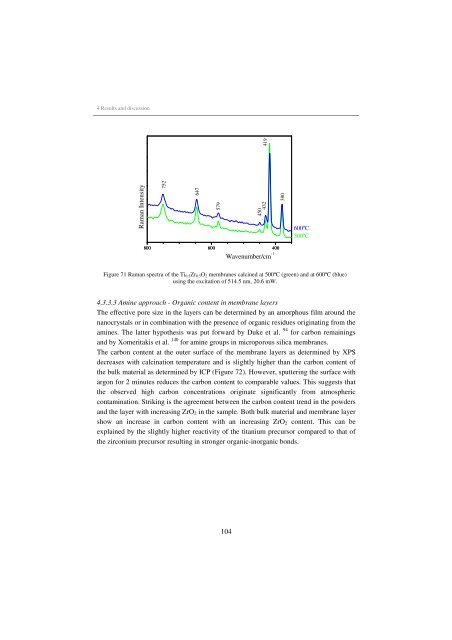Inorganic Microporous Membranes for Gas Separation in Fossil Fuel ...
Inorganic Microporous Membranes for Gas Separation in Fossil Fuel ...
Inorganic Microporous Membranes for Gas Separation in Fossil Fuel ...
You also want an ePaper? Increase the reach of your titles
YUMPU automatically turns print PDFs into web optimized ePapers that Google loves.
4 Results and discussion<br />
Raman Intensity<br />
752<br />
647<br />
579<br />
800 600 400<br />
Wavenumber/cm -1<br />
104<br />
419<br />
432<br />
450<br />
380<br />
600ºC<br />
500ºC<br />
Figure 71 Raman spectra of the Ti0.5Zr0.5O2 membranes calc<strong>in</strong>ed at 500ºC (green) and at 600ºC (blue)<br />
us<strong>in</strong>g the excitation of 514.5 nm, 20.6 mW.<br />
4.3.3.3 Am<strong>in</strong>e approach - Organic content <strong>in</strong> membrane layers<br />
The effective pore size <strong>in</strong> the layers can be determ<strong>in</strong>ed by an amorphous film around the<br />
nanocrystals or <strong>in</strong> comb<strong>in</strong>ation with the presence of organic residues orig<strong>in</strong>at<strong>in</strong>g from the<br />
am<strong>in</strong>es. The latter hypothesis was put <strong>for</strong>ward by Duke et al. 94 <strong>for</strong> carbon rema<strong>in</strong><strong>in</strong>gs<br />
and by Xomeritakis et al. 140 <strong>for</strong> am<strong>in</strong>e groups <strong>in</strong> microporous silica membranes.<br />
The carbon content at the outer surface of the membrane layers as determ<strong>in</strong>ed by XPS<br />
decreases with calc<strong>in</strong>ation temperature and is slightly higher than the carbon content of<br />
the bulk material as determ<strong>in</strong>ed by ICP (Figure 72). However, sputter<strong>in</strong>g the surface with<br />
argon <strong>for</strong> 2 m<strong>in</strong>utes reduces the carbon content to comparable values. This suggests that<br />
the observed high carbon concentrations orig<strong>in</strong>ate significantly from atmospheric<br />
contam<strong>in</strong>ation. Strik<strong>in</strong>g is the agreement between the carbon content trend <strong>in</strong> the powders<br />
and the layer with <strong>in</strong>creas<strong>in</strong>g ZrO2 <strong>in</strong> the sample. Both bulk material and membrane layer<br />
show an <strong>in</strong>crease <strong>in</strong> carbon content with an <strong>in</strong>creas<strong>in</strong>g ZrO2 content. This can be<br />
expla<strong>in</strong>ed by the slightly higher reactivity of the titanium precursor compared to that of<br />
the zirconium precursor result<strong>in</strong>g <strong>in</strong> stronger organic-<strong>in</strong>organic bonds.

















